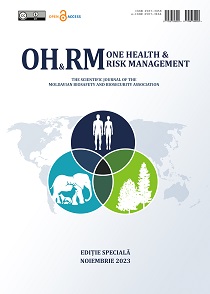Abstract
Introduction. Cutaneous anthrax in Azerbaijan is an endemic disease among people, particularly in regions with active cattle breeding. Over the period from 2018 to 2022, an average of 12-15 cases were recorded annually, primarily among the rural population. Notably, in 2022, the number of confirmed cases experienced a significant increase. Surveillance for anthrax, along with other infectious diseases, is conducted through the electronic surveillance system for infectious diseases (EIDSS).
Aim. To assess the reason for the increase in the number of anthrax cases in Azerbaijan, utilizing surveillance timeliness indicators.
Material and methods. We conducted an analysis of the electronic database in EIDSS of the Ministry of Health, focusing on initially reported cases of cutaneous anthrax among humans for the year 2022. The surveillance system was assessed, incorporating timeliness indicators, such as the date when the patient first sought care, the urgency of notification, case entry, initiation of epidemiological investigations, and the completeness of information in the fields related to collected and tested samples. The conventionally assumed threshold value for surveillance indicators is 80% of all cases reported to the system. Laboratory confirmation of samples from suspected cases is performed using both the PCR method and bacteriological methods. Methodological documents used for the evaluation included the “Rules for the Surveillance and Control of Especially Dangerous Infections” (Ministry of Health, Azerbaijan) and the “Updated Guidelines for Evaluating Public Health Surveillance Systems” (CDC, Atlanta).
Results. In 2022, a total of 58 human cases of cutaneous anthrax were reported in EIDSS, with 25 cases confirmed by positive laboratory results. Further investigation into cases with negative laboratory results revealed that some patients had self-administered antibiotics and ointments before seeking medical attention. Despite clinical symptoms being present among cases with negative test results (e.g., papules in 91% of cases) and significant risk factors (such as handling meat in 24.2% of cases), there was a notable difference in the timeliness of seeking medical care (p<0.05). While the average time from the onset of symptoms to the first medical visit for confirmed cases was 4.5 days, it was 7.8 days for cases with negative laboratory results. The timeliness of emergency notification, case entry into EIDSS, and the initiation of epidemiological investigations for both confirmed cases and cases with negative test results did not significantly differ and exceeded the threshold level of 80% for all reported cases, as required in the country. The adequacy and completeness of filling in the fields of the laboratory module scored 100%. In the context of a One Health approach investigation, no cases were reported in EIDSS among animals.
Conclusions. The evaluated timeliness indicators are equally high and exceeded the threshold level for both confirmed cases and cases with negative laboratory results. However, the revealed late appeal of the population with suspected anthrax and self-administration of antibiotics requires the adoption of appropriate measures to educate the population about the risk factors, prevention and effectiveness of timely contacting a medical institution.
|
 Views: 95|
|
Views: 95|
|
This work is licensed under a Creative Commons Attribution 4.0 International License.

